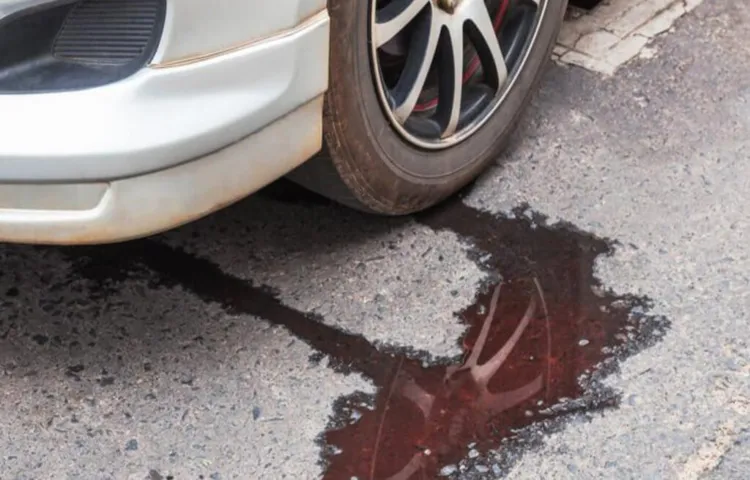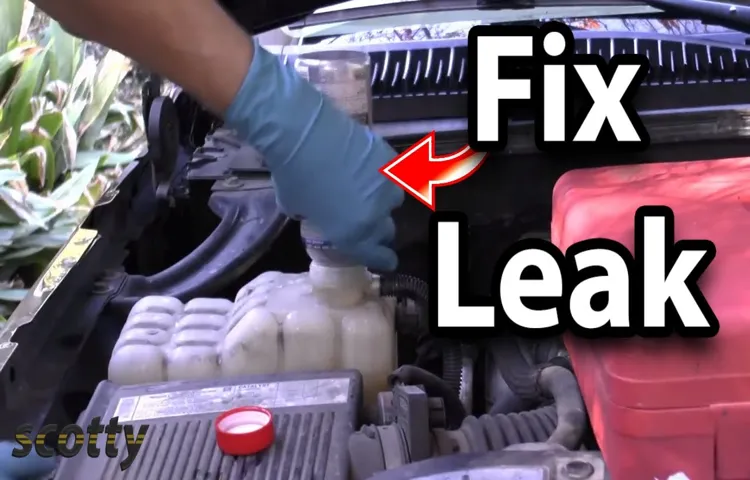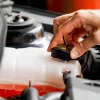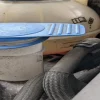Imagine this: you’re driving down the road, and suddenly you notice that your car’s temperature gauge is rising. You pull over and pop the hood, only to find that your coolant level is low. Panic sets in, and the first question that comes to mind is, “Where is the leak?” Coolant leaks can occur in various places in your car’s cooling system, and locating them can be a challenging task.
However, detecting and repairing them early can save you from costly repairs in the long term, and keep your car running smoothly. In this comprehensive guide, we have compiled all the essential information you need to know about locating coolant leaks. We break down various signs that your car’s coolant system is leaking, including low coolant levels, unusual smells, and high engine temperatures.
We also outline the most common places where coolant leaks can occur, such as the radiator, hoses, water pump, and head gasket. Alongside that, we provide you with practical tips on how to locate and repair these leaks, from using a UV dye to checking for rust and corrosion. If you’re worried about the health of your car’s cooling system or want to educate yourself on what to do in case of a coolant leak, then this guide is for you.
With our comprehensive approach, we guarantee that you’ll be well-equipped to identify, address, and solve any coolant leak issue that comes your way.
Table of Contents
Potential Causes of Coolant Leaks
If you suspect that your car’s coolant is leaking, it’s important to pinpoint the issue right away to prevent further damage to your engine. There are several potential causes of coolant leaks, including a faulty water pump, damaged radiator, cracked hoses, or a blown head gasket. One way to determine where the coolant is leaking from is to visually inspect your engine for any signs of coolant residue or wet spots.
You can also check your coolant levels to see if they are consistently dropping, which can indicate a leak. If you’re still unsure where the coolant is leaking from, it’s best to take your car to a trusted mechanic who can diagnose and fix the issue. Don’t ignore a coolant leak, as it can lead to overheating or engine failure in the long run.
Failed Hoses and Hose Clamps
Coolant leaks in vehicles can be caused by various factors, one of which is failed hoses and hose clamps. These components are designed to handle extreme heat and pressure, but over time, they can deteriorate and result in leaks. Hose clamps may become loose or corroded, while hoses can crack or split due to wear and tear.
Additionally, using low-quality or incompatible hoses and clamps can also contribute to leaks. It’s important to periodically inspect these components and replace them as needed to ensure your vehicle’s cooling system remains in good working order. By doing so, you can prevent overheating and engine damage, which can be costly to repair.

Damaged Radiator
A damaged radiator can cause your vehicle to leak coolant, which can lead to engine damage and overheating. But what causes these coolant leaks in the first place? One potential cause is a rusted or corroded radiator. Over time, exposure to moisture and other environmental factors can cause the metal in your radiator to oxidize and deteriorate, creating weak spots that can eventually lead to leaks.
Another potential cause of coolant leaks is a damaged or worn-out gasket or seal. These crucial components are responsible for maintaining a tight seal between the various components of your cooling system, and if they become damaged or worn, coolant can easily escape. Additionally, physical damage to your radiator, such as impacts or punctures, can also lead to coolant leaks.
Whether it’s caused by rust, gasket failure, or physical damage, it’s important to address any coolant leaks as soon as possible to prevent further damage to your vehicle.
Cracked Engine Block or Cylinder Head
If you find yourself dealing with a coolant leak in your vehicle, it is important to identify the root cause in order to make necessary repairs. One potential cause of a coolant leak could be a cracked engine block or cylinder head. This is a serious issue that requires immediate attention, as it can lead to significant engine damage.
Some common culprits of a cracked engine block or cylinder head include overheating, corrosion, and engine vibrations. Overheating can cause the metal components of the engine to expand and contract, eventually leading to cracks. Corrosion can weaken the metal over time, making it more prone to cracking.
Engine vibrations can also cause stress and strain on the engine, leading to cracks. If you suspect a cracked engine block or cylinder head, it is important to have a professional mechanic diagnose and repair the issue promptly to prevent further damage.
Visual Inspection of the Engine
When it comes to engine maintenance, keeping an eye on coolant levels is crucial. If you notice that your coolant levels are dropping consistently, then you likely have a leak. The first step to figuring out where the coolant is leaking from is to conduct a visual inspection.
Check the engine and surrounding areas for any signs of coolant leaks. Look for green or orange liquid, puddles, or stains on surfaces or parts. If you can’t find any obvious leaks, start the engine and let it run for a few minutes.
Watch closely for any signs of leaking coolant. Check for any steam or smoke coming from the engine, as this can indicate a coolant leak or overheating. If you still can’t locate the leak, it may be time to take your vehicle to a mechanic who can perform a more thorough inspection.
Remember, catching coolant leaks early can help prevent serious engine damage down the road.
Checking for Coolant Puddles
When checking under the hood of your car, examining the engine for any signs of wear and tear is essential. One of the crucial things to look out for is coolant puddles. Coolant is essential for maintaining the temperature of the engine.
Any leaks can lead to overheating or engine failure. A visual inspection of the engine can help you identify any coolant puddles around hoses, connections, or the radiator. If you notice any spots or dampness, it is time to take your car to the mechanic for a check-up.
Ignoring the issue can lead to costly damage in the long run. Therefore, regular visual inspections can help you catch any potential issues and prevent further damage to your vehicle. In conclusion, keeping an eye out for coolant puddles is an excellent way to ensure the longevity of your car’s engine.
Tracing Stains and Residue
When it comes to inspecting an engine, a visual examination can reveal a lot about its condition. One critical aspect of a visual inspection is tracing stains and residue that could indicate a problem. Stains from oil, coolant, or other fluids can reveal a leaking gasket or a cracked component.
Similarly, residue buildup around different parts, such as the intake manifold or exhaust system, could indicate internal engine issues or general wear and tear. It’s essential to pay attention to such stains and residue buildup as they can often lead to bigger problems if left unaddressed. By regularly inspecting and detecting these potential issues, you can avoid costly repairs and ensure that your engine operates optimally.
Examining the Water Pump
When it comes to ensuring the health and longevity of your vehicle, a visual inspection of the engine is crucial. One component that deserves your attention is the water pump. This is responsible for keeping the engine cool and preventing it from overheating.
During your inspection, you should check if there are any leaks or signs of damage, such as corrosion or rust. It’s also important to see if the water pump’s pulley and belt are in good condition, as a worn-out belt can cause problems down the line. Don’t neglect this important part of your car’s engine system – a damaged water pump can lead to costly repairs and leave you stranded on the side of the road.
Pressure Testing the Cooling System
One common problem with the cooling system in your car is coolant leaks. Sometimes it can be difficult to tell exactly where the coolant is leaking from. That’s where pressure testing comes in.
By pressurizing the system, you can locate any leaks and determine the best course of action for repairs. First, ensure the coolant is at the proper level and the radiator cap is tightly sealed. Next, attach the pressure tester to the radiator and pump it up to the appropriate pressure level indicated in your car’s manual.
Keep an eye on the gauge to ensure the pressure doesn’t drop. If it does, there is likely a leak somewhere in the system. Use a flashlight and a mirror to inspect the hoses, water pump, radiator, and other components for any visible signs of leaking.
If no leaks are immediately visible, you may need to use a UV dye to locate the source of the leak. By finding and fixing the leak, you can prevent more serious damage to your engine and keep your car running smoothly.
Using a Coolant Pressure Tester Kit
If you’re experiencing cooling issues with your vehicle, pressure testing the cooling system may be a necessary step in diagnosing the problem. In order to do so, you’ll need to use a coolant pressure tester kit. These kits allow you to pressurize the cooling system and check for leaks or other issues that may be reducing the system’s efficiency.
To use the kit, first make sure your engine is cool, then remove the radiator cap and insert the pressure tester adapter. Next, pump the tester until it reaches the recommended pressure level, which can usually be found in your vehicle’s owner’s manual. If the pressure drops, this indicates a leak.
The coolant pressure tester kit is a valuable tool for diagnosing and resolving issues with your vehicle’s cooling system, helping you keep your car running smoothly and efficiently.
Identifying Leaks Under Pressure
One of the most reliable ways to identify leaks in the cooling system is to perform a pressure test. This test is carried out using specialized equipment that pressurizes the cooling system to a predetermined level, usually above the normal operating pressure. The idea is to increase the pressure enough to reveal any leaks in the system.
During the test, the technician closely inspects the cooling system for signs of leakage, such as a drop in pressure, visible cracks, or coolant stains. If a leak is detected, it can be quickly repaired before it causes any major damage. Pressure testing is a crucial diagnostic tool that can save you time and money in the long run by pinpointing any leaks in the system before they become more serious issues.
So, if you notice any signs of a cooling system leak, don’t delay – book a pressure test today to identify and resolve the problem!
Professional Diagnostics
If you suspect your vehicle is leaking coolant, it’s essential to identify the source of the problem as soon as possible. Not only will this prevent further damage to your vehicle, but it will also save you money on costly repairs. One way to tell where coolant is leaking from is by using professional diagnostics.
A mechanic can perform a pressure test on your cooling system to determine where the leak is coming from. They can also check the color of the coolant to see if it’s the same as the brand you use, which will indicate the source of the problem. Additionally, they can inspect the hoses and connections to see if there are any visible signs of damage or wear and tear.
By using professional diagnostics, you can ensure that your coolant leak is repaired promptly and effectively, allowing you to get back on the road with confidence.
Turning to a Mechanic or Technician
When your car is showing signs of trouble, it’s always a wise decision to turn to a mechanic or technician for professional diagnostics. These professionals have the experience and expertise to diagnose any issues your car may be experiencing accurately. They have access to specialized diagnostic tools and advanced technology that can help them find even the most elusive problems in your vehicle’s system.
Trying to diagnose a car problem without the knowledge and experience of a professional can lead to further damage, making the issue worse or even causing additional problems. By trusting a mechanic, you can expect to receive an accurate diagnosis and expert advice on how to fix the issue. The peace of mind that comes with knowing your car is in good hands makes it a worthwhile investment.
Main Keyword: professional diagnostics.
Diagnostic Tools
Professional diagnostics tools are essential for mechanics and technicians to accurately diagnose problems within vehicles and machinery. These tools allow professionals to find and address issues quickly and efficiently, saving both time and money. Some examples of these diagnostic tools include code readers and scan tools, which read the codes that are produced by a vehicle’s onboard computer system.
These codes can provide valuable insights into the cause of a problem, helping mechanics to identify the root of the issue. Other diagnostic tools include multimeters and oscilloscopes, which can be used to measure electrical signals and test various components within a vehicle. By using professional diagnostic equipment, mechanics can provide better service to their customers, help keep vehicles running smoothly, and ultimately, ensure safety on the roads.
Conclusion
In conclusion, tracking down a coolant leak can be a challenge, but with careful observation and some investigative skills, you too can become a coolant sleuth. Just remember to look for clear signs of dripping or pooling, trace back the source of any stains or residue, and don’t be afraid to follow your nose. And if you’re still stumped, just remember – sometimes the answer is right in front of you, but you just need to know where to look (and sniff).
Happy hunting!”
FAQs
What are the common signs of a coolant leak?
Some common signs of a coolant leak include low coolant levels, visible leaks or puddles under the vehicle, a sweet smell coming from the engine, overheating, or steam coming from the engine.
How do I check my coolant levels?
To check your coolant levels, first make sure the engine is cool. Then locate the coolant reservoir and check the level against the minimum and maximum indicated marks. Add more coolant if necessary.
Can I use water instead of coolant in an emergency?
Yes, in an emergency situation, you can use water instead of coolant to keep your engine from overheating. However, this is not recommended as it does not have the same anti-corrosive and anti-freezing properties as coolant.
How can I tell if my radiator is leaking?
If your radiator is leaking, you may notice puddles or stains under the vehicle, a low coolant level, visible damage or cracks in the radiator, or steam coming from the radiator.
What should I do if I suspect a coolant leak?
If you suspect a coolant leak, it is important to have it inspected and repaired as soon as possible to prevent engine damage or overheating. Take your vehicle to a trusted mechanic or dealership for diagnosis and repairs.



